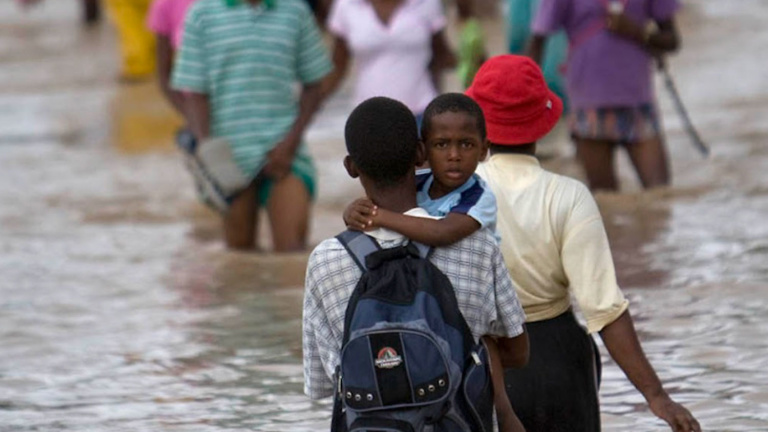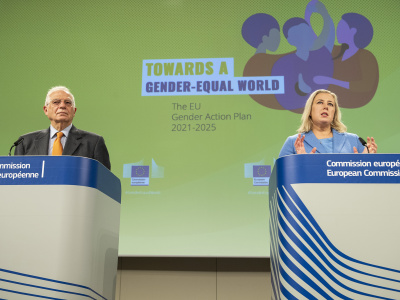
Climate change, conflict and displacement: Sides of the same coin
Climate change is increasing the incidence of extreme weather events with the potential to destroy millions of dollars of personal property and public infrastructure. As households and businesses adapt to this new normal, the international community must see migration and security not as separate outcomes but as diametrical extremes of the simple need for adaptation.
A more volatile, less predictable future
Heat waves, droughts, floods, hurricanes, cyclones and wildfires. Extreme weather events have increased in frequency and severity. With continuing climate change, the Intergovernmental Panel on Climate Change reports that such events will also fluctuate more in spatial extent, duration and timing.
Recent years have witnessed the potential of such events to displace thousands of people in a very short time, creating new challenges in provision of disaster relief. Not only do affected areas require recovery and rebuilding, but large diasporas place stress on destination communities. This can lead to conflict, as social and economic systems become overtaxed and scarcity more noticeable. Moreover, large groups of people on the move pose a security risk, particularly when traversing national borders.
The climate–migration–conflict nexus
The links between climate change, migration and security are complex. Climate change has been found to cause migration and to exacerbate the risk of conflict. In some cases, migration is the intervening factor between adverse weather and conflict while, in other cases, migration is itself the consequence of climate-induced conflict.
Both are evident in Syria. Here, massive drought led to a collapse of agricultural production, prompting many rural residents to abandon their homes and go on the move. The influx of migrants into Syrian cities magnified existing social unrest, and this likely contributed to the outbreak of civil war. The civil war has prompted even more migration, with large numbers of Syrians seeking refuge in Turkey and Europe. This migration, too, has created new security risks, straining long standing diplomatic ties and provoking violent protests.
This kind of cycle between migration and conflict can be self-perpetuating. Climate change feeds into the nexus as a “threat multiplier”, intensifying competition for already scarce resources, including food, water, energy and even habitable land. Security risks may begin internally but can easily spread internationally, affecting poor and rich countries alike, particularly in the face of global challenges such as infectious diseases and terrorism.
Twin symptoms of maladaptation
Underlying these complex, multidirectional linkages between climate, conflict and migration is the unremitting need for adaptation. When wildfires and soil salinisation strain local industries, other options must be found. In general, people prefer to stay in place. Thus, where alternative local livelihoods are viable, population displacement will be minimal. But, without migration as a release valve, local population pressures are more likely to ignite conflict. On the other hand, migration can trigger conflict in destination areas, even as it eases the situation at the place of origin.
Migration and conflict, therefore, are opposing symptoms of the same condition: lack of resilience and limited capacity to adapt. In the case of migration, a lack of local options forces people to move out, which may trigger conflict in receiving communities. In the case of local conflict, people who choose to stay clash over increasingly scarce resources, which may prompt later waves of migration.
Enhancing resilience to climate change can simultaneously alleviate migration flows and minimise security concerns. With more opportunities to adapt in place, vulnerable communities will feel less pressure to migrate, and those who stay will face less competitive pressure as resource use is diversified. However, resilience need not mean staying in place. Where local options have been exhausted or the environment has become too volatile, migration may be essential to avoid conflict. Indeed, those who are trapped in place may be at the greatest risk of either instigating or experiencing conflict, or both.
Managing migration to mitigate conflict
To address migration and security effectively, we must recognise these phenomena as not simply linked but as part and parcel of the same underlying process. By reframing the climate–migration–conflict nexus around local resilience, we can see both mobility and immobility as precursors to security threats. Where mobility is high, there is greater risk of conflict in migrant-receiving areas. But, where mobility is low, there is greater risk of internal conflict, as a scarcity mentality drives people towards increasingly desperate options.
Proactive approaches to climate migration can offer another means to mitigate security risks. This may mean stemming population outflows by creating more opportunities locally, particularly those that shift the economy to more sustainable patterns of resource use. These could include developing crops that are tolerant of drought, heat or poor soil quality to diminish the impact of climate change on agriculture. Encouraging the development of non-farm industries in rural or peri-urban areas can also reduce the need for migration, while setting the stage for more balanced and equitable growth in the future.
Perhaps more challenging will be recognising when adapting is not, or ceases to be, a viable option. In these cases, migration flows need to be not only directed but encouraged, using a variety of policy levers ranging from zoning and real estate laws to managed retreat. Anticipating the need for migration out of environmentally vulnerable areas is key to pre-empt broader security risks, as it allows for more deliberate placement of residents across both time and space. This will be particularly important in areas where catastrophic events have the potential to rapidly displace or impoverish large numbers of people, as in cases of sea level rise and desertification.
Former US President Ronald Reagan observed, “Peace is not absence of conflict; it is the ability to handle conflict by peaceful means.” Similarly, migration and conflict are not distinct consequences of climate change but, rather, contrasting expressions of a singular underlying challenge: the need to develop climate resilience.
About the author
Joyce Chen is Associate Professor of Agricultural, Environmental and Development Economics at Ohio State University.
E-mail: chen.1276@osu.edu; Twitter: @midwestjoyce
Read the full magazine issue








